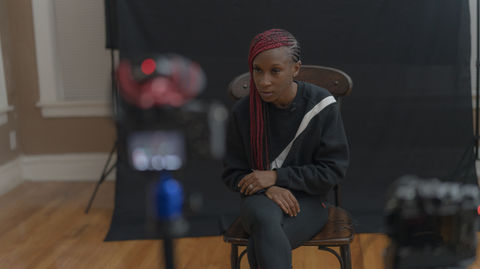FOOTWORK SAVED MY LIFE:
THE EVOLUTION OF CHICAGO FOOTWORK
Chicago Footwork originated in the inner-city of Chicago in the 1985. It is an urban
dance style characterized by multiple combinations of rapid, improvised, syncopated
movements of the feet, often accompanied by symmetrical hand gestures. The dance
is inseparable from its music: “footwork tracks.” Tracks are continuous loops of
kickdrums, claps, and basslines, offset by Hip Hop, R&B, and now Black Gospel
samples, at 160 Beats Per Minute. Footwork has been dismissed as a “lower” form of art
performed by Black youth on the South and West sides of one of the most segregated
cities in the nation. The performance and study of Chicago Footwork now transcends
racial, cultural, and national boundaries, and is performed on many World stages.
The Footwork Saved My Life: The Evolution of Chicago Footwork five-part docuseries is
a collection of narrative stories that weave together the evolution and history of the art form and culture known as Chicago Footwork, from 1985 to the present. The five episodes capture the socio-cultural, economic, and political forces that give shape to
each of the five generations of Chicago Footwork. Some consist of decades of political corruption; socially engineered gang rivalries; the disinvestment in public housing;
disparate educational systems; and the police force’s hyper-surveillance, brutalization,
and criminalization of poor and working-class Black and Brown youth. Essential to the
story of its evolution, however, is how the practitioners have harnessed Chicago
Footwork as a mode of expression—an embodied vernacular language of resistance—and as a vehicle to combat this extant and complex system of state-
sanctioned, violence across generations, both consciously and unconsciously. While
the film will mostly capture Footwork’s Chicago roots, it will also highlight its now global
presence, from Chicago to Minnesota, to L.A. to Tokyo and India, to the Favelas of
Brazil.
Footwork Saved My Life utilizes myriad humanistic approaches to tell the story of
Chicago through a cinema-verité audiovisual style, combining both live-action and
archival footage, narration, still images, and oral history interviews. The most critical
resource for this project are the men and women who make up the Chicago Footwork
family regionally, nationally, and internationally. Thus far, we have captured almost 200
oral interviews with community members, historians, activists, and famous (and
infamous) individuals/personalities in the Footwork world.
Tentative Episode Titles and Generations:
Episode One: Generations 0 and 1: “In The Beginning”:
1985-1990: Subtitle: “The Embryo”
1990-1997: Subtitle: “Blind Faith”
Episode Two: Generation 2: 1997-2004: “The Turning Point”
Episode Three: Generation 3: 2005-2012: “The Digital Era”
Episode Four: Generation 4: 2012-2019: “Rebellion: Birth of the Global”
Episode Five: Generation 5: 2019-the Present: “The Reset”
**Most episode titles have been decided in consultation with Footworker, Trax producer, and Footwork Historian, Isaac “Crossfire” Harris, and the world renowned Footwork DJ, RP Boo.**

FOOTWORK IS A BLACK VERNACULAR DANCE OF LIBERATION.
“Footwork is a Black vernacular dance of liberation. Following Claudia Rankine, the
Black body is a corporeal storage-house of racially objectionable systems, practices
and structures, such as the militarized policing of the Chicago Police Department, the
exclusionary and racialized zoning of urban developers, or the political machine’s
withholding of resources—all resulting in impoverished, violence-ridden
neighborhoods. Footwork is an attempt to “metabolize” (Rankine 28) the anger resulting
from these systems of oppression and their injurious effects on the Black
community. Where normative modes of subversive expressions have been muzzled,
footwork arms the dancers with a voice to critique such inequalities and to tell their
personal stories” – Battle

THE MOVEMENT OF THE FOOTWORKING BODY IS METAPHYSICALLY GEOGRAPHICAL, INDICATIVE OF THE WILL TO TRANSCEND THE STRUCTURAL CONFINEMENTS OF CHICAGO...
“The movement of the footworking body is metaphysically geographical, indicative of
the will to transcend the structural confinements of Chicago. . . Overcrowded in
overpriced homes, suffocating, and deprived of resources, Black and Brown
neighborhoods see unprecedented levels of intra-communal gang and gun violence, as
well as anti-Black violence at the hands of repressive forces. When I interviewed DJ
and dancer, Shannon “Lucky” Riley of Teklife, who now resides in Las Vegas, he referred
to Chicago as a “cage” that he desperately needed to escape: “As soon as I got out of
there, I felt like, man, I can breathe. It’s like now, like – let me explore life.” Most dancers
aren’t fortunate enough to physically escape like Lucky, and traverse physical borders
in search of opportunities to acquire property and real wealth-generating
opportunities—freedom. To this end, footwork becomes the metaphysical antidote,
enabling their “travels” to imagined spaces of liberation beyond their shackled material
realties. I argue that one of those spaces “traveled” to is an Afro-Diasporic spiritual past,
which is always renewing itself in the present” – Battle
3rd/4th Generation Footworker Sir Timo discusses Footwork as an embodied response to geographical "imprisonment" in Chicago, one of the most segregated cities in the nation.
FILM CLIPS & INTERVIEWS



































